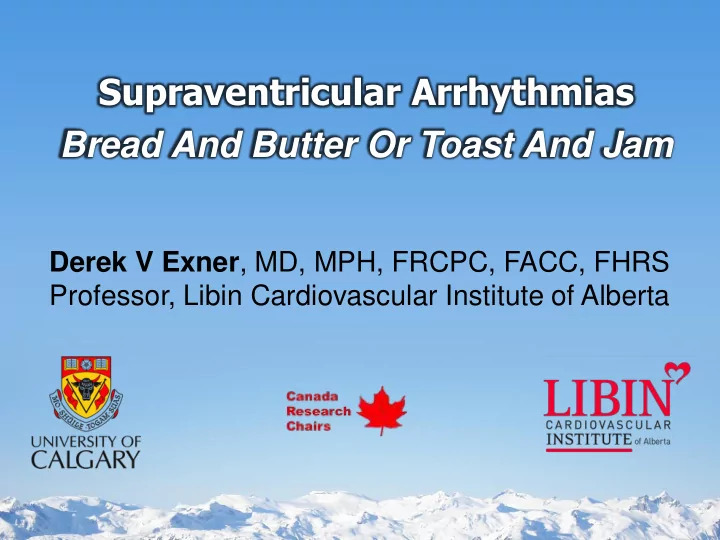

Supraventricular Arrhythmias Bread And Butter Or Toast And Jam Derek V Exner , MD, MPH, FRCPC, FACC, FHRS Professor, Libin Cardiovascular Institute of Alberta ACC Rockies 2012
Overview Back to the basics Unraveling the lexicon Bread and Butter • Wide QRS tachycardia • Irregular narrow complex tachycardia Toast and Jam • Regular narrow QRS tachycardia Putting knowledge into action ACC Rockies 2012
Starting with the Basics ACC Rockies 2012
Common SVT Types & Features Type Freq. Features AV Node Reentry • Pseudo R 1 in V1 # 1 (AVNRT) • ± Manifest AV Reentry (AVRT) # 2 • Atrial Tachycardia Altered P wave # 3 (AT) morphology ACC Rockies 2012 Medi et al. MJA 2009 ; 190: 255 – 260
Anatomic Lexicon of SVT AVNRT Slow-Fast Fast-Slow AVRT Orthodromic Antidromic Atrial flutter Counterclockwise Clockwise ACC Rockies 2012
Other Things to Consider Diagnosis Features • Idiopathic sinus tachycardia Inappropriate Sinus Tachycardia (IST) Female healthcare workers Postural Orthostatic • ± Other autonomic findings Tachycardia Syndrome (POTS) ACC Rockies 2012 Medi et al. MJA 2009 ; 190: 255 – 260
Less Common SVTs Type Features Permanent Junctional • Children Reciprocating • Rate related CM Tachycardia (PJRT) • Junctional ectopic Children • tachycardia (JET) Discrete AV node focus • AP involving AVN & His-P Mahaim tachycardia • From RA to RV near RBB ACC Rockies 2012 Medi et al. MJA 2009 ; 190: 255 – 260
Bread and Butter ACC Rockies 2012
Eight Nine Steps to Unraveling SVT (1 of 2) 1. QRS width & regularity. 2. Evidence of atrial activity. 3. If distinct P waves • RP relationship • P wave morphology in SVT (& NSR) • AV relationship (1:1, 2:1, dissociated) 4. If flutter waves seen or suspected • Evaluate P morphology (slow R rate) ACC Rockies 2012 Kumar & Scheinman. Cardiol Clin 2006 :24:427-37
Approach to Narrow Complex Tachycardia ACC Rockies 2012
Regular WCT: Summary of Four Studies 285 consecutive stable patients (tertiary care centres) – 230 had VT (81%) – 180 with VT had prior MI (78%) – Regular WCT + Prior MI = VT 98% of the time Tchou, P et al . Am J Med, 1988 Steinman et al. JAMA 1989 Baerman JM et al. Ann Emerg Med 1987 Akhtar M et al. Ann Int Medi 1988 ACC Rockies 2012
Know that pre-ECG prob. of SVT is 5% To achieve post-ECG prob. of SVT > 90%, require a LR ~ 200 Even a powerful LR (e.g., > 10) changes post-ECG prob. of Pre- LR Post- SVT to ~ 30% test test ACC Rockies 2012
Regular Wide Complex Tachycardia Absence of RS in all precordial ? No Yes RS > 100 ms ? VT No Yes AV Dissociation ? VT No Yes VT Morphology in V 1-2 & V 6 ? VT No Yes VT SVT ACC Rockies 2012 Brugada P. Circulation 1991 ;83:1649-59.
QRS Morphology Versus Brugada Algorithm 102 consecutive patients, 69 (68%) had VT – VT is the default unless match for typical BBB Sensitivity Specificity Brugada Criteria 83% (57/69) 67% (22/33) Typical BBB Criteria 91% (63/69) 85% (28/33) Griffith MJ et al. Lancet 1994 ACC Rockies 2012
“Down Hill Mogul ” in Leads V 1 & V 2 VT Favoured if A is > 30 ms Kindwall 1988 Notching (B) C is > 70 ms Wellens. Heart 2001 ;86:579-85 ACC Rockies 2012
“ Regular Narrow Complex T achycardia” 58 year old man: lightheaded; BP 108/62 ACC Rockies 2012
Wide “ Regular Narrow Complex T achycardia” 58 year old man: lightheaded; BP 108/62 ACC Rockies 2012
Regular WCT History of MI: > 95% will be VT Evidence for VT – AV Relationship • Dissociated P-waves, Fusion & Capture – QRS morphology • Brugada Criteria, others Adenosine may be helpful Require adequate data (12 lead / old ECG) ACC Rockies 2012
Toast and Jam ACC Rockies 2012
Eight Nine Steps to Unraveling SVT (1 of 2) 1. QRS width & regularity. 2. Evidence of atrial activity. 3. If distinct P waves • RP relationship • P wave morphology in SVT (& NSR) • AV relationship (1:1, 2:1, dissociated) 4. If flutter waves seen or suspected • Evaluate P morphology (slow R rate) ACC Rockies 2012 Kumar & Scheinman. Cardiol Clin 2006 :24:427-37
Where do you look for P Waves ? Needle in the Haystack Principle ACC Rockies 2012
Simple Clues ACC Rockies 2012
Eight Nine Steps to Unraveling SVT (2 of 2) 5. If no P waves – Irreg. & non-isoelectric (AF) / pseudo R (AVNRT) 6. Assess underlying A & V rates. 7. Initiation & termination – Starts with PAC, PVC / Ends with P / QRS 8. Response to adenosine. – Terminates? How? AV block? Δ in atrial rhythm? 9. Δ in rate (cycle length) with & without BBB? ACC Rockies 2012 Kumar & Scheinman,. Cardiol Clin 2006 :24:427-37
ECG Clues Onset Morphology Termination ACC Rockies 2012
Simple Clues Orthodromic ACC Rockies 2012
Widening of QRS in Patient with WPW ACC Rockies 2012
ACC Rockies 2012
ACC Rockies 2012
ACC Rockies 2012
Pharmacological Intervention Response to Adenosine / Vagal Maneuvers ACC Rockies 2012
Adenosine as a Diagnostic Maneuver Appears safe in VT (based on a few small series) Does not terminate scar related reentrant VT May terminate some idiopathic VTs Never appropriate for IRREGULAR WCT Terminates most AVN dependent SVT Slows ventricular response to AVN independent SVT Smart when SVT is suspected ACC Rockies 2012
SVT Does Not Rule Out Other Problems ACC Rockies 2012
When to Refer to EP Specialist ? Wide QRS tachycardia Narrow SVT Severe symptoms Drug resistant or intolerant Non-pharmacological approach preferred Occupational Pre-excitation ACC Rockies 2012
Summary Keep it simple Wide QRS tachycardia • VT until proven otherwise Regular narrow QRS tachycardia • Simple, step-by-step algorithm If in doubt or concerned - call or refer ACC Rockies 2012
Recommend
More recommend